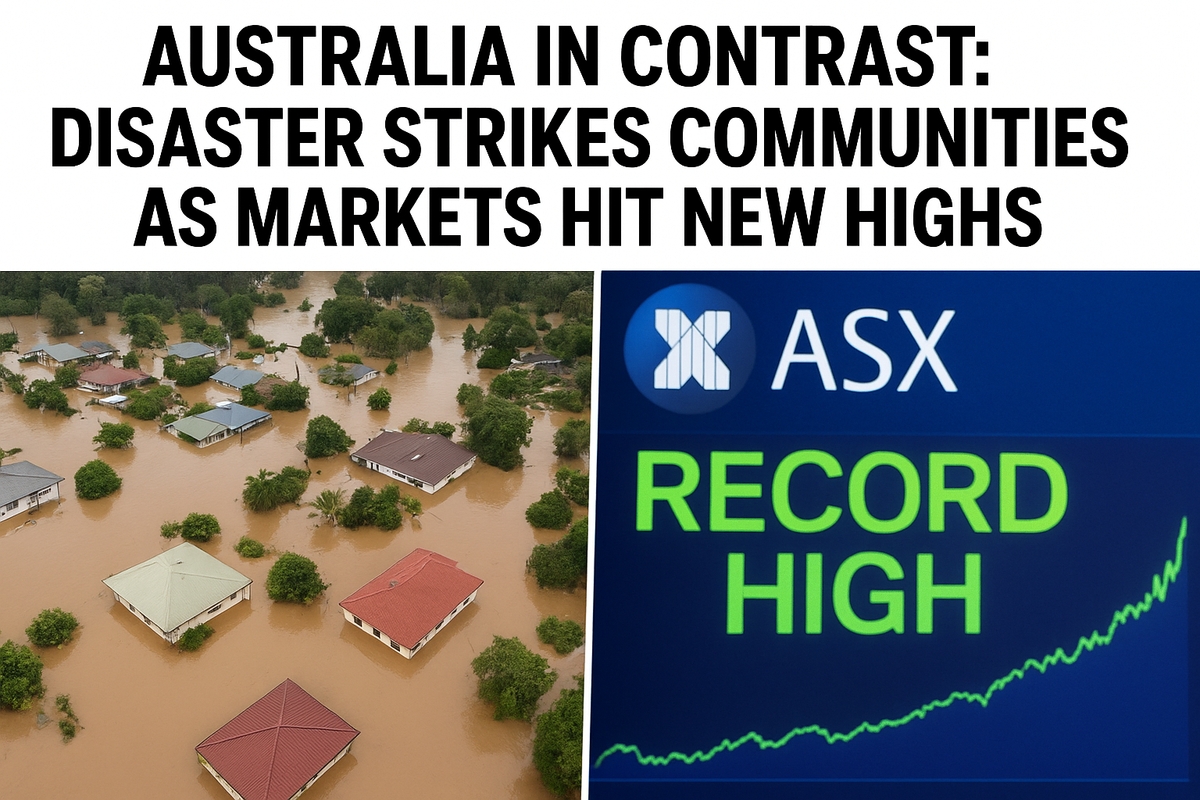Australia Floods, Fatal Crashes, and Record-High Markets: A Day of Contrasts
Australia faced a striking day of contrasts: devastating floods and fatal crashes on the ground, while the ASX soared to record highs showcasing tragedy, resilience, and the nation’s complex identity.

Australia experienced a day of striking contrasts that captured the nation’s fragility and resilience. While relentless floods swept through towns and highways witnessed devastating crashes, the stock market soared to record highs, reminding the world that tragedy and triumph often coexist in surprising ways. This paradox disaster on the ground, prosperity on the financial charts reflects the challenges and complexities facing modern Australia.
Floods Ravage Communities Across States
Torrential Rains Push Communities to the Brink
In several states, particularly New South Wales and Victoria, floodwaters surged after days of heavy rainfall. Rivers such as the Murray and Lachlan spilled over their banks, swallowing farmland, townships, and roadways. For many rural families, this was the third or fourth flood in as many years, compounding emotional exhaustion and financial strain.

The Human Struggle
- Thousands evacuated into emergency shelters.
- Entire rural towns cut off, forcing airlifts of food and medicine.
- Children pulled from rooftops, a reminder of the fragility of life during sudden surges.
Parents describe the anxiety of hearing helicopters overhead, knowing they may need to leave their homes within minutes. Many evacuees say they are not sure whether they will return to houses that are livable or at all.
Impact on Agriculture and Livelihoods
The agricultural belt of New South Wales has been hit hard. Wheat, barley, and cotton farms have been inundated. Livestock losses are mounting, threatening both local incomes and export stability. Experts warn that food prices could spike in coming months, a painful echo of the 2022 flood season.
Government & Emergency Response
The federal government has already declared natural disaster zones, providing immediate relief packages. The ADF has mobilized to assist local rescue services, deploying amphibious vehicles and aircraft to transport stranded communities. However, critics argue that despite these efforts, long-term climate adaptation strategies remain slow, leaving communities repeatedly exposed.
Fatal Crashes Amid Weather Chaos
Accidents Multiply Under Dangerous Conditions
As floodwaters made roads slick and visibility poor, highways turned into danger zones. Authorities reported a series of major crashes in multiple states, compounding the day’s tragedies.
- Queensland Highway Disaster: A fuel tanker collided with several cars, sparking a massive blaze and killing four people.
- Sydney Suburbs Crash: Two young adults lost their lives after skidding into oncoming traffic late at night.
Regional Accidents: Dozens more were injured in water-related crashes, many caused by hydroplaning on flooded roads.

Emotional Fallout
Families across the country are grappling with the shock of sudden loss. Roadside memorials are already appearing at crash sites, as communities mourn loved ones taken too soon.
Road Safety Concerns
The crashes have reignited debates over road safety in extreme weather. Transport authorities emphasize the need for:
- Stronger driver education programs about navigating dangerous conditions.
- Investment in safer roads with better drainage and flood-resistant infrastructure.
- Expanded use of real-time weather alerts for motorists.
Critics argue that while individual drivers bear responsibility, systemic shortcomings in road safety amplify risks during climate-driven disasters.
ASX Hits Record Highs
Financial Markets Defy Domestic Turmoil
While communities battled floods and accidents, the financial sector delivered a starkly different headline. The ASX 200 index surged to record highs, reflecting global investor confidence and local corporate strength.
This disconnect between lived reality and financial success underscores Australia’s paradox: hardship at home, prosperity in the markets.
Drivers Behind the Surge
- Mining Sector Strength – Demand from China for iron ore and coal buoyed major players like BHP and Rio Tinto.
- Technology Growth – Australian tech firms rallied, mirroring global trends and investor optimism in digital infrastructure.
- Banking Confidence – The Big Four banks reported solid profits, supported by stable lending and real estate resilience.
- Global Capital Inflows – Investors worldwide are channeling funds into stable economies, with Australia a top pick amid global uncertainty.
Investor Sentiment vs. Public Reality
For many Australians displaced by floods or mourning crash victims, headlines of record stock gains feel distant, even surreal. Yet investors argue that strong markets are a beacon of national resilience proof that even amid crises, the economic foundation holds firm.

A Nation of Contrasts
Symbolism of the Day
The events illustrate Australia’s dual identity: a country vulnerable to natural forces and human tragedies, yet deeply integrated into global financial systems that reward resilience.
- Nature vs. Economy: Climate disasters highlight fragility, while markets highlight strength.
- Loss vs. Opportunity: Families face grief while investors celebrate gains.
- Local vs. Global: Local realities of hardship clash with global narratives of prosperity.
Historical Context
This is not the first time Australia has embodied such contradictions. During the Black Summer bushfires of 2019–2020, while communities burned, parts of the economy thrived due to commodity exports. Similarly, during the COVID-19 pandemic, the ASX recovered quickly even as unemployment soared.
These patterns raise difficult questions about who benefits from resilience and who bears the cost of disaster.
Lessons for the Future
1. Climate Preparedness Is Urgent
The floods underscore the importance of preparing for a climate-defined future. Experts call for:
- Investment in flood-resilient infrastructure (levees, improved drainage systems).
- Policies to relocate vulnerable communities away from floodplains.
- Expanded climate adaptation funding at both state and federal levels.
2. Road Safety Reform
Fatal crashes should not be seen as isolated tragedies. They point to systemic issues requiring:
- Stronger vehicle safety standards.
- Modernized road infrastructure for better stormwater management.
- Broader use of AI-driven traffic monitoring to prevent accidents.
3. Market Resilience Requires Balance
While investors celebrate, policymakers warn against complacency. Record highs may mask vulnerabilities, such as:
- Global commodity dependence.
- Exposure to geopolitical shocks.
- Risks from domestic instability if disasters worsen.
Balancing economic opportunity with social resilience must become a policy priority.
Key Takeaways
- Floods have displaced thousands, exposing communities’ vulnerability.
- Fatal crashes reveal the deadly risks of extreme weather on Australia’s roads.
- ASX record highs showcase resilience in global markets.
- Australia’s identity reflects paradox and complexity—suffering alongside success.
Conclusion: One Nation, Two Realities
Australia’s “day of contrasts” is not just a coincidence of events it is a microcosm of a country navigating the 21st century. Floodwaters remind citizens of their fragile coexistence with nature. Roadside tragedies reveal systemic weaknesses in safety and infrastructure. Yet the soaring ASX illustrates resilience, opportunity, and optimism on the global stage.
The challenge lies in reconciling these two realities: ensuring that economic success does not overshadow human suffering, and that the prosperity reflected in stock markets translates into support for the families rebuilding their lives after disaster.
Australia today is more than tragedy and triumph it is both, simultaneously. And learning to balance these contrasts will define the nation’s future.




